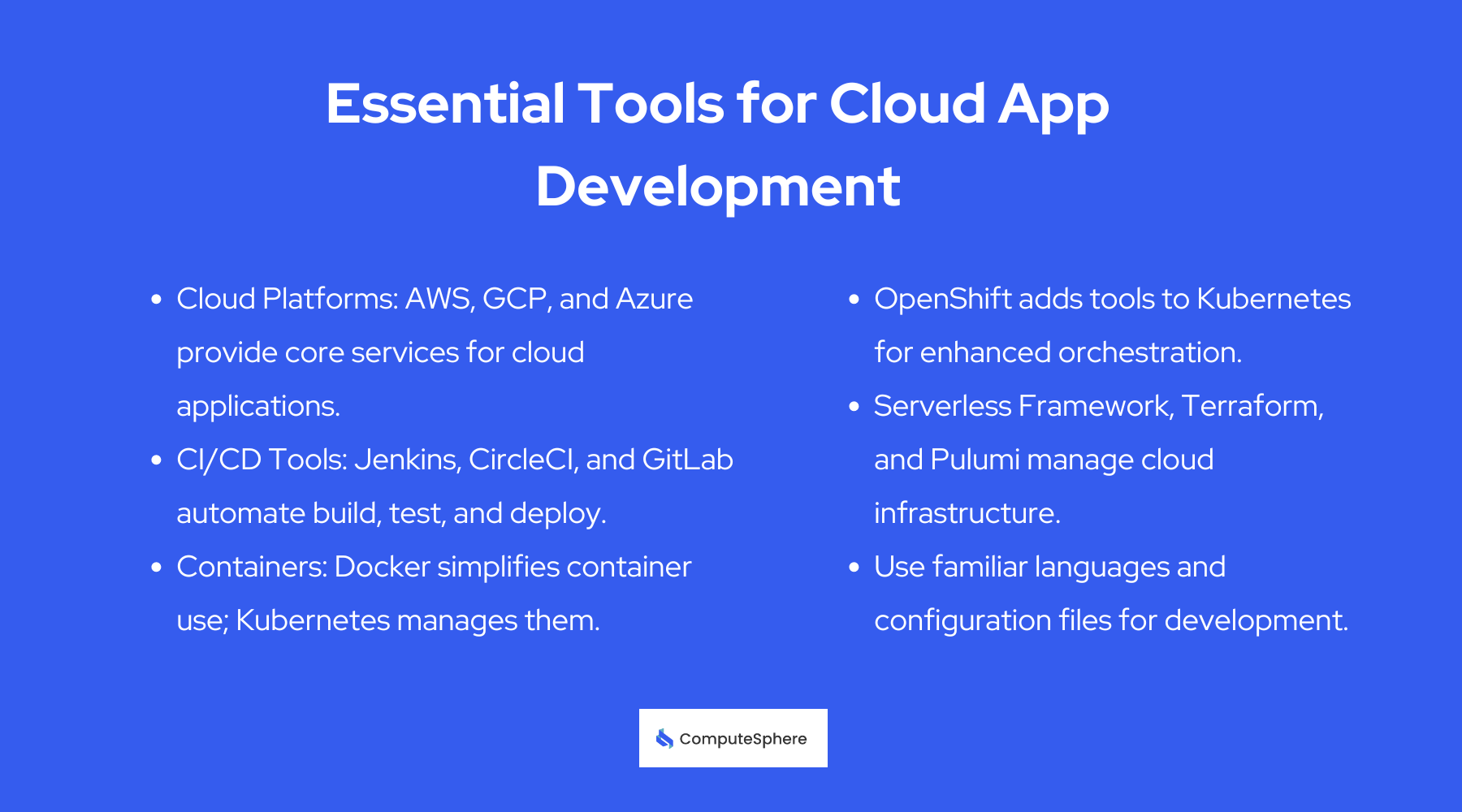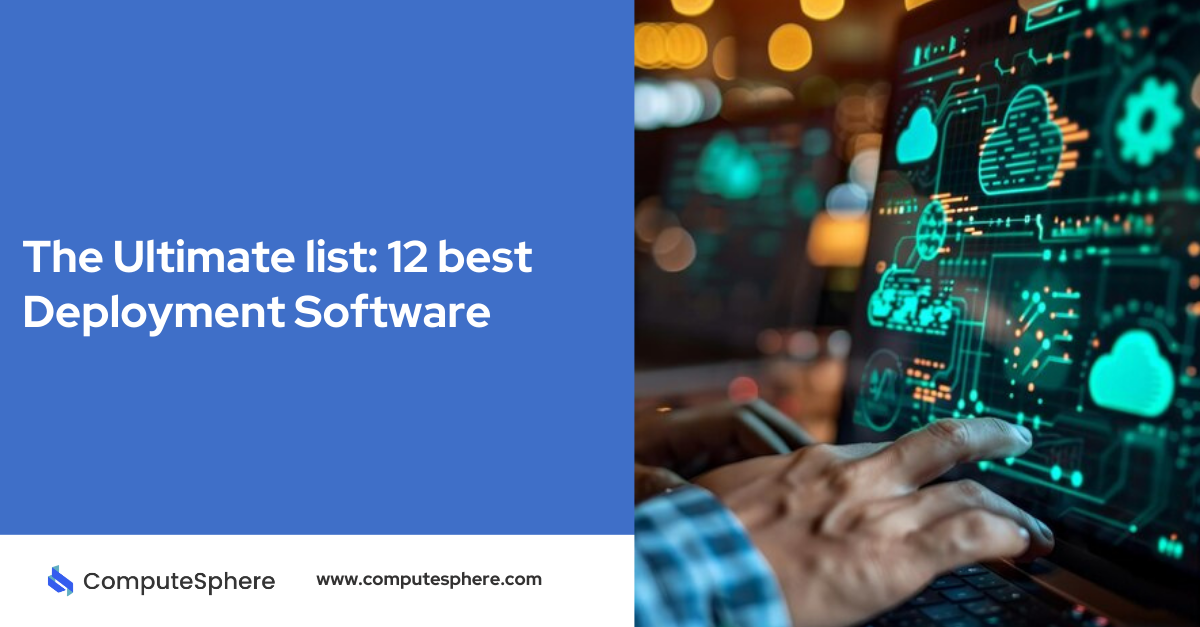Application Development in Cloud Computing: Tools and Best Practices

The historical reliance on physical computing infrastructure has presented a significant challenge for application development. The introduction of cloud computing, however, has led to a paradigm shift. Developers can now access a vast pool of resources on-demand, providing unparalleled scalability and flexibility with cloud computing. It also streamlines development workflows, allowing developers to focus on core functionalities rather than infrastructure management.
This article includes resources, that enable developers with the essential tools and best practices for success in the expanding field of cloud-based application development. So, let’s begin.
Understanding Cloud Computing
Before jumping into the tools and practices, it's important to understand what cloud computing essentials are. Cloud computing refers to the delivery of various services over the Internet, including storage, databases, servers, networking, and software. These services are hosted on remote servers rather than on-premises, providing several key advantages.
Cloud computing is characterized by on-demand self-service, broad network access, resource pooling, rapid elasticity, and measured service. These features make it highly adaptable to different business needs. There are three main types of cloud services: Infrastructure as a Service (IaaS), Platform as a Service (PaaS), and Software as a Service (SaaS). Each has unique benefits, from providing virtualized computing resources to delivering software applications on a subscription basis.
The primary benefits of cloud computing in application development include scalability, cost-efficiency, flexibility, and improved collaboration. Businesses can easily scale resources up or down based on demand, significantly reducing costs compared to traditional IT infrastructure.
Essential Tools for Cloud-Based Application Development
To fully utilize cloud computing, you need the right set of tools to facilitate the development, deployment, and management of applications in the cloud. Understanding why and how these tools can be beneficial is important for their effective use.

Cloud Service Providers
AWS (Amazon Web Services), Google Cloud Platform (GCP), and Microsoft Azure are foundational for building and running applications in the cloud. The main reasons to use these providers are their scalability, global reach, and comprehensive services. These allow applications to handle varying loads; and global reach, with data centers worldwide for low-latency access; and comprehensive services from machine learning to data analytics. They enable rapid deployment and scaling of applications, provide powerful security and compliance features, and reduce costs and maintenance by eliminating the need for physical hardware.
Continuous Integration/Continuous Deployment (CI/CD) Tools
CI/CD tools automate the build, test, and deployment process. They improve efficiency by automating repetitive tasks, improving quality assurance through continuous testing, and enabling faster delivery with streamlined workflows. Jenkins, CircleCI, GitLab CI/CD, and GitHub Actions maintain code quality by running tests automatically on every code commit. They facilitate continuous delivery of updates to production, improving user satisfaction and allowing developers to focus on coding rather than deployment management.
Containerization and Orchestration Tools
Tools like Docker and Kubernetes have reshaped application development and deployment. Docker ensures consistency across different environments by packaging applications with all dependencies. Kubernetes automates the deployment, scaling, and management of containerized applications, making it easier to handle complex microservices architectures.
Infrastructure as Code (IaC) Tools
Serverless Framework, Terraform, and Pulumi are essential for managing infrastructure and building serverless applications. These tools automate infrastructure provisioning and management, enable version control of infrastructure configurations, and allow the use of familiar programming languages and configuration files.
Serverless Framework simplifies serverless application development across multiple cloud providers. Terraform provisions infrastructure across various cloud services with a common configuration language. Pulumi allows developers to define and manage cloud resources using real programming languages, integrating seamlessly with development workflows.
Best Practices for Cloud Application Development
Building applications in the cloud requires adhering to several best practices to ensure efficiency, security, and cost-effectiveness.
First, design for scalability and performance. Adopting a microservices architecture can improve scalability and maintainability. In a microservices setup, an application is broken into small, independent services that communicate over a network. This allows each service to be developed, deployed, and scaled independently. For example, in an e-commerce platform, services for user authentication, product catalog, and payment processing can scale separately based on demand.
However, microservices may not always be the best choice. For smaller applications with simpler requirements, a monolithic architecture might be more appropriate due to its simplicity and ease of development. When deciding on the architecture, consider factors like the application's complexity, team size, deployment frequency, and scalability needs.
Using auto-scaling and load balancing is important for managing varying workloads. Auto-scaling adjusts the number of active instances based on demand, improving optimal performance, and cost efficiency. Load balancing distributes traffic across instances, preventing any single instance from becoming a bottleneck, thus enhancing performance and reliability.
Second, ensure security and compliance. Implement strong authentication and authorization mechanisms to protect your applications. Ensure data is encrypted both at rest and in transit. Regularly conduct security audits and compliance checks to identify and mitigate vulnerabilities.
Third, manage costs effectively. Upgrade resource usage by shutting down unused services and right-sizing your resources. Use cost management tools like AWS Cost Explorer or Azure Cost Management to monitor and control your cloud spending. Regular cost reviews will help you identify and implement cost-saving strategies.
Fourth, implement comprehensive monitoring and logging. Monitoring tools like CloudWatch and Azure Monitor provide valuable data on application performance and health. Centralized logging solutions like the ELK Stack or Fluentd help aggregate and analyze logs, making it easier to diagnose and fix issues.
Fifth, incorporate automated testing into your CI/CD pipelines. Automated testing tools like Selenium, and JUnit are essential for ensuring code quality and catching issues early in the development process.
Finally, maintain comprehensive documentation and improve collaboration. Good documentation helps your team and future developers understand the system. Collaboration tools like Confluence, Slack, and Microsoft Teams improve team communication and productivity.
Conclusion
Wrapping up, the transformative power of cloud computing on application development cannot be overstated. This innovative paradigm gives developers new flexibility, scalability, and efficiency, enabling them to construct powerful, secure, and adaptable cloud-based applications. However, the ever-evolving technological landscape necessitates continuous learning.
You must stay updated with shifts, like containerization and serverless architectures, which will ensure sustained progress. With cloud computing, security considerations are ever-present. Ensure powerful security protocols for safeguarding data and applications. No doubt, with cloud computing and a culture of continuous learning, you are close to building innovative and future-proof applications.
Contents
Built for Builders. Priced for Startups.
Tired of unpredictable cloud bills? ComputeSphere offers modular, fixed-cost cloud hosting that grows with your startup—no DevOps headaches, no surprises.
Get StartedShare this article
Browse Some Related Blogs
Relevant and related contents you can read









